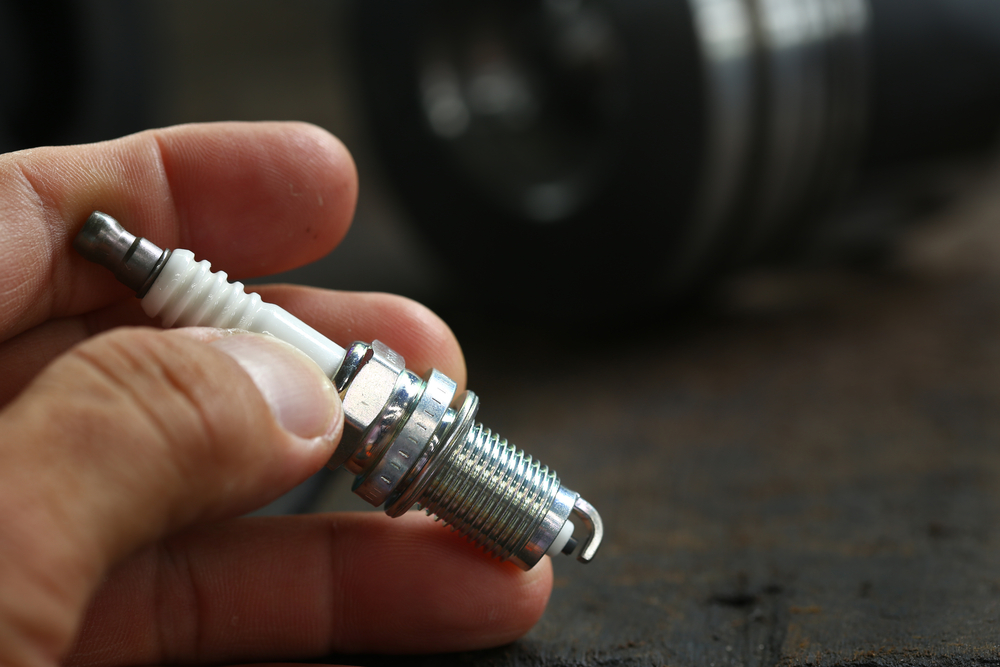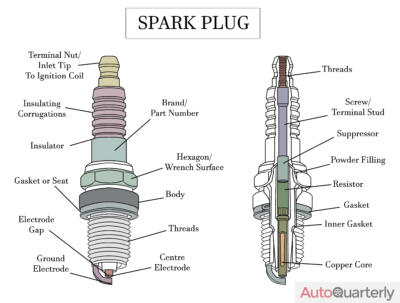Spark plugs are important. They are necessary for keeping your gasoline-powered engine running. Unfortunately, they wear out over time and will need replacing. When you replace them, you will have the option of upgrading them as well.
The two most prominent upgraded plugs are platinum and iridium. In this guide, we’ll look at some pros and cons and talk about what makes them different. After, we’ll provide you with some tips and tricks on installing new plugs.
What Is a Spark Plug?
Your car converts burning fuel into mechanical energy. To burn that fuel, you need three things: air, fuel, and ignition. Spark plugs produce a spark that ignites the air/fuel mixture.
Your ignition system produces a high amount of energy fed into the spark plug, where it jumps in the form of plasma from one metal part to another, which creates the spark. If you want to get really into the details of how they work, the oil company Mobil has a fantastic in-depth article here.
Spark plugs are wear items. It’s expected that you will have to replace your plugs since the hot plasma and harsh conditions will break them down over time. When it does come time to replace your plugs, something you can tell by reading your owner’s manual, you’ll be forced to choose between three main types of spark plugs. Before you consider upgrading your spark plugs, check your car’s owner manual or do a quick search online. You may actually be damaging your car or making it run worse if it’s specifically designed for a copper plug and you install a different type.
Copper
Copper spark plugs are the cheapest plugs available and are most commonly found on older vehicles. They are also found on some high-performance vehicles.
Most spark plugs have a copper core. What sets copper plugs apart is the nickel alloy electrode. The electrode is larger than other types and requires more energy to use as a result. Most people upgrade from standard copper plugs because they wear out very quickly; a copper plug lasts about 20k miles before needing to be replaced.
Platinum
Platinum spark plugs have a platinum electrode. They can either be single or double. Single plugs are cheaper but only have a platinum electrode. Double plugs have a platinum side electrode so that the spark can jump in both directions.
The electrodes are smaller, which allows them to run well at lower voltages, and the electrodes are much harder, so they will last a lot longer. A car with single platinum plugs can be upgraded to iridium or double platinum but should not be downgraded to a copper plug. Cars with double platinum plugs must use plugs with upgraded side electrodes.
Iridium
Iridium plugs, as you might be able to guess, use iridium instead of platinum for the center electrode. Iridium is very hard, and it’s a very good conductor. That allows an iridium plug to last a lot longer and operate much more efficiently. They are, however, very expensive. Iridium is a fairly rare material, and it costs a lot to build something out of it.
Spark Plug vs. Glow Plug
If you have been around diesel motors, you’ve probably heard of glow plugs. Glow plugs do not operate like spark plugs. In fact, a diesel motor does not need a spark to operate. They can run purely on compression and ambient heat; the diesel fuel will combust simply because it’s hot enough in the cylinder. A glow plug simply heats up the chamber if it’s too cold to start. They are called glow plugs because they actually emit orange light, just like a space heater, since they work in a nearly identical way.
Choosing the Best One for Your Car
The most important thing to do before you choose a new set of spark plugs for your car is to read the manual. If your car requires an iridium plug, you need to buy an iridium plug. If your car requires a colder, copper plug, you shouldn’t upgrade to a hotter platinum plug.
However, many cars don’t require anything specific. They come with copper plugs because copper plugs are cheap, but you may get better gas mileage and save money in the long run by upgrading to platinum or iridium.
The Advantages of Platinum
Platinum plugs are an excellent value, and that’s their greatest advantage. Even though they cost one or two dollars more per plug than copper, they can last three times as long. You’ll save money in the long run simply because you won’t have to buy them as frequently.
The other advantage platinum has over copper is its ability to run hotter. With a hotter spark, the engine runs more efficiently and stays cleaner. That translates directly into better performance and fuel economy for many motors.
The Advantages of Iridium
Iridium plugs last even longer than platinum plugs. In fact, the chances are good that if you put iridium spark plugs into your motor, you will sell the car before you have to replace them. They are also the most efficient plugs you can get. They require very little power to produce a reliable spark.
They do cost quite a bit more, though. They don’t last twice as long as platinum plugs will, but they can often cost twice as much. That’s only a negative if you replace the plugs yourself, though. If you are paying for someone’s labor, it’s still a lot less expensive to buy one set and never have to worry about it again.
How to Tell if You Need New Plugs

There are two main ways to tell if you need new spark plugs. The first is very straightforward; you check your automotive service schedule. Most manufacturers will recommend replacing the plugs somewhere between 30k miles and 50k miles, although cars that come standard with iridium plugs may be fine for 80k miles.
The second way to tell that you need new plugs is that you notice something wrong.
Symptoms of Weak Spark Plugs
The following symptoms are ones you will notice as you operate your vehicle. If you do notice these issues, consider picking up a spark plug test tool like this one. They are inexpensive and are a necessary tool if you plan on working on your own car regularly.
- You notice you are getting lower MPGs.
- Your car idles poorly, especially if you hear a pinging noise while idling.
- Your check engine light comes on. If it does, use an OBD reader like the ones we recommend here to confirm that it’s a spark issue and not a fuel issue.
- You notice that your car is not accelerating as well as it used to.
- You fail a smog precheck. In states that require regular inspections, the inspection site will tell you if they suspect you need a “tune-up.” A tune-up usually refers to new spark plugs, wires, an oil change, and a new distributor cap on older vehicles.
Physically Inspect the Spark Plug
If you suspect that your spark plugs are not operating correctly, the next step is to pull the plugs out and physically inspect them. Champion, one of the oldest spark plug manufacturers in the US, has a great write up here about what to look for when you pull a suspicious spark plug.
How to Replace Your Spark Plugs
Replacing your spark plugs is one of the most approachable projects you can do for your car. You don’t need very many tools, and most vehicles are designed in a way that leaves the spark plugs easily accessible.
Items Needed
- Plug Socket: Most plug wrenches are simply sockets that have a rubber ring to hold the spark plug in place while you position them. They come in different sizes, so it’s helpful to buy a set like this one.
- Socket Accessories: Sometimes, it can be very difficult to reach the plug, which is where having universal joints and extensions can save you. This set is perfect for any shop and will help with many other projects.
- Socket Wrench: It doesn’t have to be a socket wrench; you just need something to attach the plug tool to. Lots of people prefer t-wrenches like this one instead of standard socket wrenches.
- Anti-Seize
- Spark Gapper
- Dielectric Grease (Optional)
Process
- Take an old cardboard box and draw a rough outline of your engine, including a mark for each spark plug. Use a screwdriver or knife to make a hole for each spark plug. You will put the old plugs in their corresponding hole as you remove them. That way, if there are any problems, you will already know where to start looking.
- Label and remove the spark plug wires or coil packs. Whenever you work on cars, it doesn’t matter what you are doing; you should strive to label and document everything. It makes it much easier to put it all back together.
- Clean the area around the plugs. You don’t have to do a deep clean, but you should use a rag to wipe the area clean so you don’t risk knocking crud into the cylinders.
- Remove the old spark plugs using the plug wrench. Inspect them as you remove them; they will often warn you about potential issues. You can check NGK’s chart at the bottom of this page for an in-depth guide on what to look for.
- Remove the new spark plugs from their packaging and inspect them. Always check new components for damage because few things in life are as frustrating as installing a new part only to find out it’s defective after you put the car back together.
- Gap the spark plug to the correct gap for your car. You’ll have to find the gap spec online or in your service manual, and here is a quick video on how to properly gap a plug.
- Apply a thin layer of anti-seize to the threads of the new spark plugs.
- Screw the plugs in one at a time while being careful not to knock dirt into the plug hole or contaminate the anti-seize. Just hand tight at first.
- Once all the plugs are in, use the plug socket wrench to tighten them down. You should tighten them down to their torque specification with a torque wrench. However, you are usually just going to spin them in by hand and then tighten them down with a half-turn using the plug wrench.
- Apply a thin layer of dielectric grease to the inside of the spark plug boots. Some people skip this step, but it can prevent the boot from seizing to the spark plug. It can also prevent electrical “leaks” between the spark plug wire and the engine block and seal the boot against moisture.
- Re-install the labeled wires/coils to their corresponding spark plugs.
That’s it. Congratulate yourself on a job well done.
Paying a Mechanic

If you don’t feel like getting dirty, most mechanics will charge you about an hour of shop time to do a partial tune-up. That means you can expect to pay between $200-300 dollars depending on how many cylinders you have and how expensive the spark plugs you need are.
If you do go the route of paying a mechanic to do it, you will usually get a better deal if you do a complete tune-up. A good mechanic can change the packs, wires, and oil while replacing the plugs, meaning that you only have to pay an additional fee for the parts.
Wrap Up
Ultimately, regardless of whether you choose platinum or iridium plugs, keeping your plugs fresh is a great way to make sure you are getting the best performance out of your engine. Be sure to check your maintenance schedule and make sure your car can handle an upgraded plug before switching. Finally, make sure to label your wires as you unhook them.



